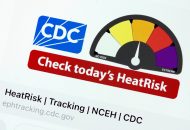Global Leaders Seek to Eliminate Pediatric HIV by 2030

The COVID-19 pandemic has disrupted routine health services making it difficult to deliver high-quality care to pregnant women and children living with HIV. But it has also pushed global leaders to try and reinvigorate global commitments to eliminate pediatric HIV by 2030.
“Children living with HIV face a stark reality, they make up 4% of all people living with HIV, and they make up 14% of the deaths, and that’s because treatment coverage is abysmal,” said Shannon Hader, deputy executive director of UNAIDS and assistant secretary-general of the United Nations.
HIV, known as the human immunodeficiency virus, attacks the immune system and is often transmitted through contact with infected blood, semen, or vaginal fluids. In the case of children, HIV is often transmitted to an infant through pregnancy or breastfeeding, and in many cases, is left untreated or diagnosed until the child is older.
Currently, there are over 850,000 children living with HIV who are not in care and treatment, according to the United Nations.
“At a local level, you have to think about where do we find these kids, what’s different than dealing with infant clinics, and how do you incentivize it,” Hader said.
Last week, the United Nations adopted a set of new and ambitious targets in a political declaration at the United Nations General Assembly High-Level Meeting on AIDS, to prevent 3.6 million new HIV-infections and 1.7 million AIDS-related deaths by 2030.
To formulate a plan, the Center for Strategic and International Studies Global Health Policy Center brought together experts from the Pediatric AIDS Foundation, ViiV Healthcare, PEPFAR, UNAIDS, Elizabeth Glaser Pediatric AIDS Foundation, and the Global Fund.
“This year was the most inclusive strategy process ever, we had inputs from over 10,000 stakeholders in 160 countries,” Hader said.
Since early spring, these agencies have undergone multiple efforts to change the approach to pediatric HIV treatment, development, and research, with the UNAIDS board approving a new strategy to combat inequities and the Global Fund developing a new strategy to be finalized and approved later this year.
There was the launch of the global accelerator for pediatric formulations network, housed in the World Health Organization, called GAP-f, which was conceived to build on and formalize the model developed within the HIV community to provide a sustainable mechanism that ensures that safer, more effective, and more durable pediatric formulations are developed and made available to children against an accelerated timeline.
The Vatican took steps to try to accelerate working with regulators, drug companies, and other stakeholders like UNICEF and the World Health Organization, on the development and uptake of HIV and TB diagnostics and medicines for children, known as the Rome Action Plan.
“We’ve got a political declaration that sets the tone for the next five years, we’ve got a strategy characterized and approved by UNAIDS with an enormous amount of input, but the shift that has to occur at the national level is a political determination to get it done,” said Charles J. Lyons, president and chief executive officer of the Elizabeth Glaser Pediatric AIDS Foundation.
COVID-19 played a role in both dismantling the work being done to combat HIV among youth and strengthening the need for policy efforts to address the gaps in kids who are diagnosed with HIV who are not getting treatment.
“Perhaps we can get more interest, when we put these pandemics together, to not just procuring, but to actually committing to the maintenance of point of care diagnostics and viral diagnostics at the scale and resourcefulness that we need them at,” Hader said.
Still, she said that to achieve the goal of eliminating pediatric HIV, there would need to be better detection of the kids with HIV who aren’t currently captured in data.
“If we don’t want to do this every year, we still need to find every single positive kid who’s being born, who is an infant. And right now, we only have 60% coverage of early infant diagnosis at two months, so we’re still missing 40% of the exposed kids,” said Hader.
Hader said PEPFAR, the President’s Emergency Plan for AIDS Relief, has been trying to locate these children through focused strategies like finding them through parents and by use of an index test which helps identify if their child has developed HIV through transmission.
“We have to talk to the parents and find out, what would it take for you to want to know your kid is positive, of course everybody wants their kid to be healthy… but do you really want to open up a box that has something that might scare you, unless there is the support around to take that on,” said Hader.
Hader said that another important strategy might be to lower the age of consent for older adolescents to be able to get self-testing or go to the clinic on their own to fill in the missing gaps, and that services should be also differentiated to avoid common discriminatory care practices.
“We know there are a certain amount of remaining infections from women getting newly infected during pregnancy or breastfeeding. Who are those women, and how are we reaching them more intensively in a preventive manner?” asked Hader.
To answer that, PEPFAR has been working to integrate women’s health services into family planning and maternal and child health service delivery sites and utilizing service delivery sites as entry points for vulnerable subpopulations including adolescent girls and young women.
PEPFAR is also working to prevent mother-to-child transmission for pregnant and breastfeeding women through enhanced access to PrEP, also known as pre-exposure prophylaxis, which is a medicine that those who are at risk of HIV often take to prevent getting HIV from sex or injection drug use.
Last year in June, the U.S. The Food and Drug Administration approved a drug called dolutegravir, referred to as pediatric DTG, for treating children down to four weeks of age who have HIV, and the regimen has become the superior treatment when compared to others on the market like Lopinavir or Ritonavir.
“We have been constantly working with our partners to push country teams to transition all children to pediatric DTG, as quickly as possible, irrespective of the amount of Lopinavir or Ritonavir that countries have in stock. It’s just not acceptable to have a superior regimen, and not push in the direction to get kids there,” said Angeli Achrekar, acting U.S. Global AIDS coordinator and special representative for Global Health Diplomacy in the U.S. State Department..
Currently four countries have already received their first shipment of pediatric DTG, and there are 19 countries that will receive their pediatric DTG by the end of this year.
“It’s been a great week… but I think we still have a long way to go to flip the script, and maybe look at our global framework as supporting what we need for political will and political action on the ground, at the country and regional level,” Hader said.























